Forced and Mandatory Leave Samples
-

Office Forced and Mandatory Leave
download now -
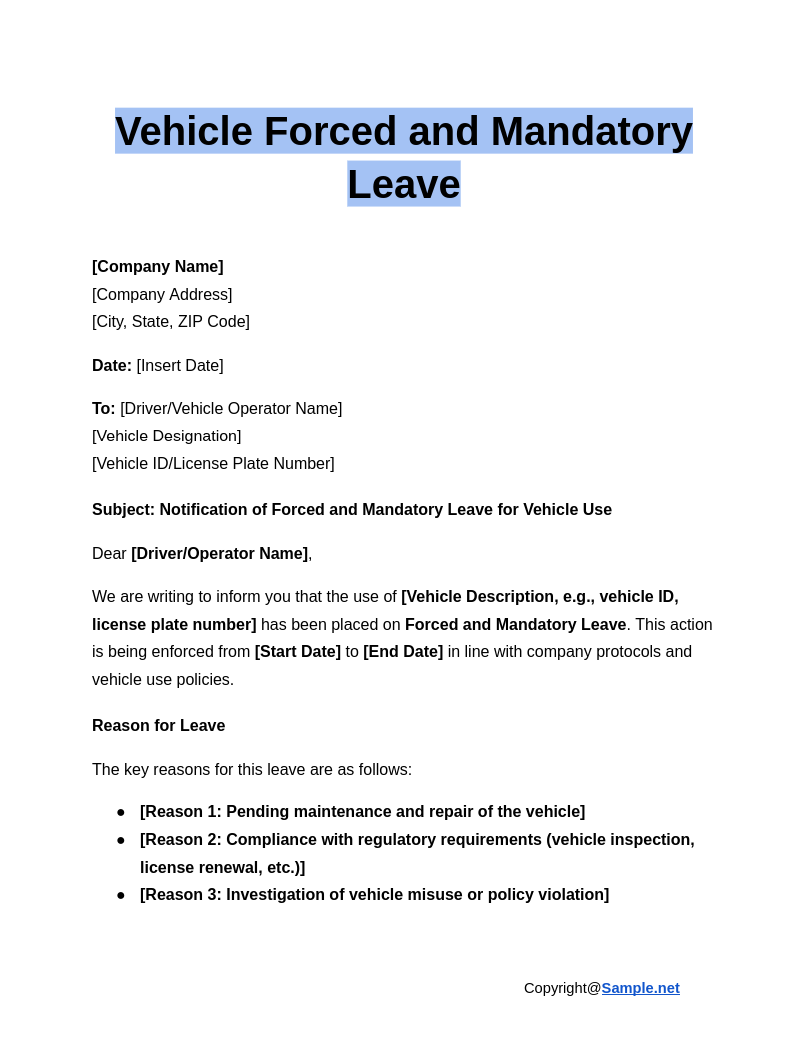
Vehicle Forced and Mandatory Leave
download now -
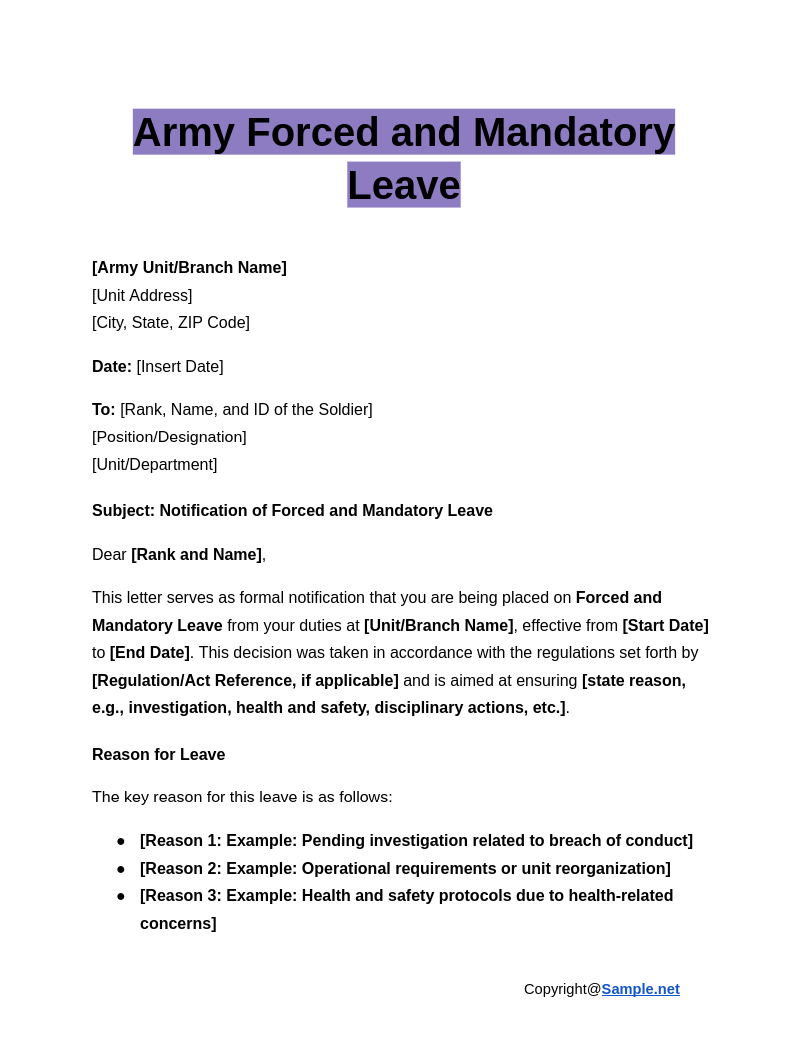
Army Forced and Mandatory Leave
download now -
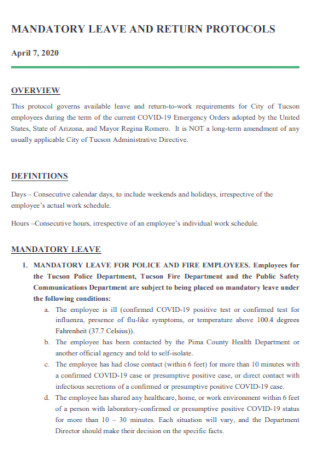
Mandatory Leave and Paid Leave Template
download now -
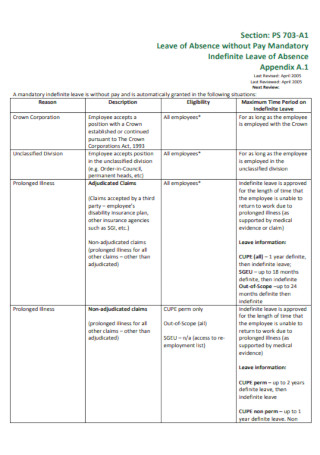
Covid 19 Leave of Absence without Pay Mandatory
download now -
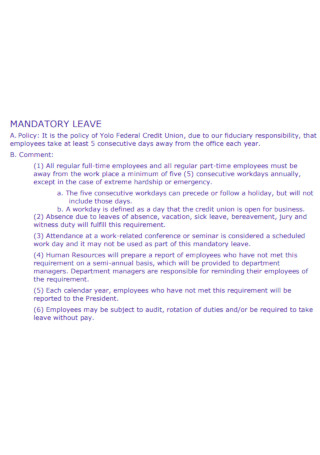
Sample Mandatory Vacation Time Leave
download now -
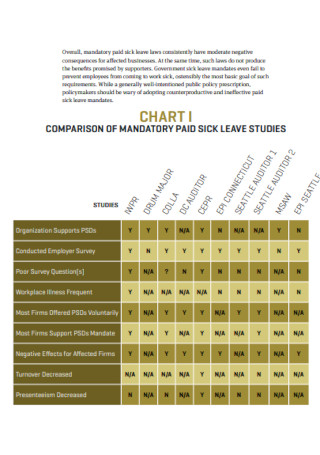
Mandatory UnPaid Sick Leave Letter
download now -
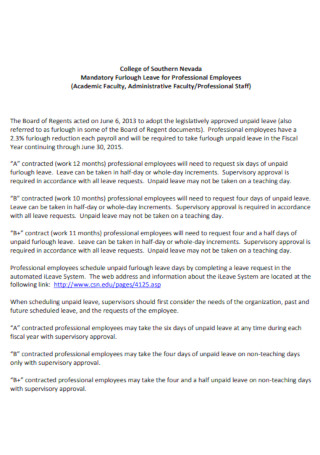
Forced and Mandatory Overtime Leave
download now -
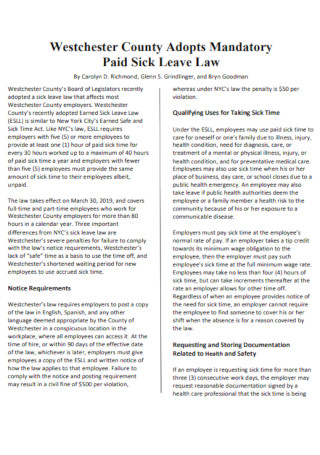
Simple Emergency Mandatory Paid Sick Leave
download now -
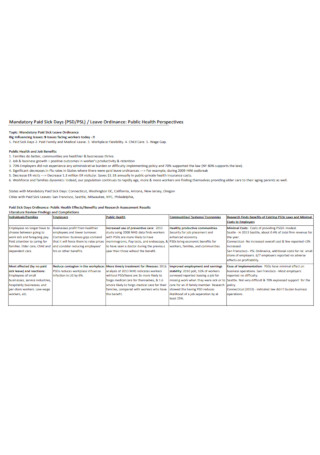
Mandatory Paid Sick Days Leave
download now -
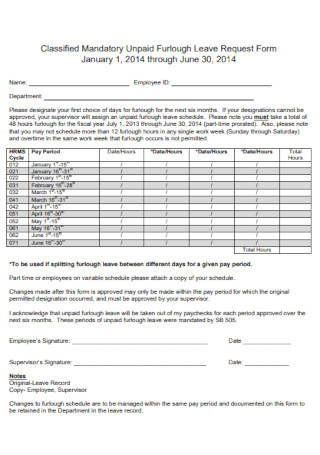
Mandatory Unpaid Furlough Leave Request Form
download now -
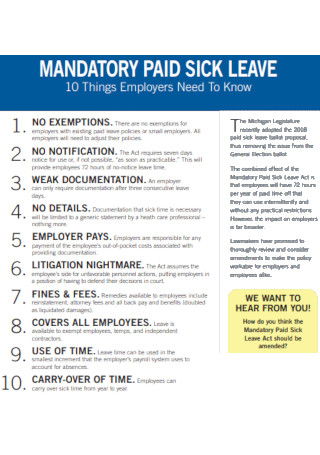
Basic Mandatory Paid Sick Leave
download now -
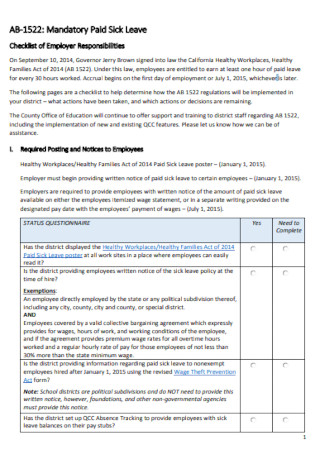
Formal Mandatory Paid Sick Leave
download now -

Mandatory Leave for Small Business
download now -
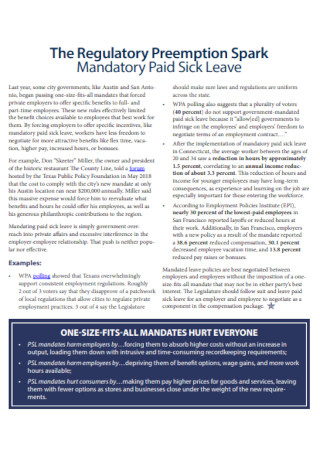
Mandatory Foundation Leave
download now -
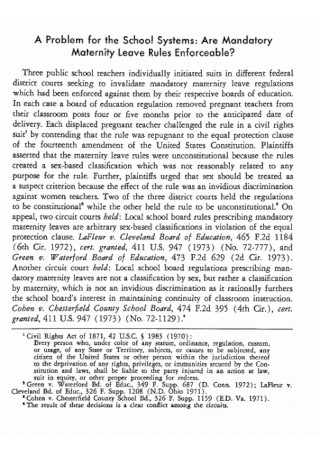
Mandatory Maternity Leave
download now -

Mandatory Sick and Safe Leave
download now -
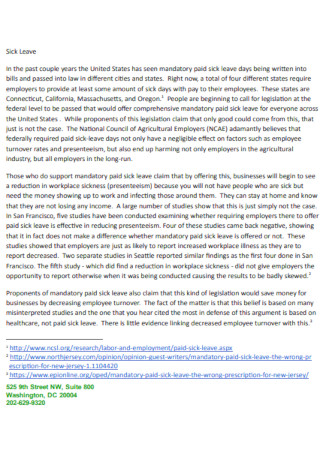
Mandatory Sick Leave
download now -
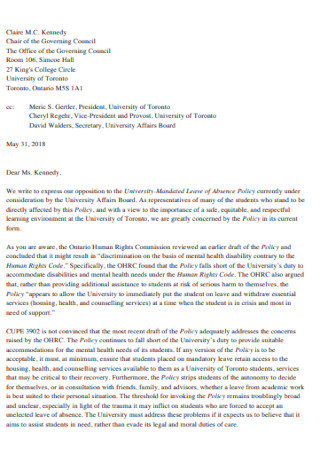
Sample Mandatory Leave Letter
download now -
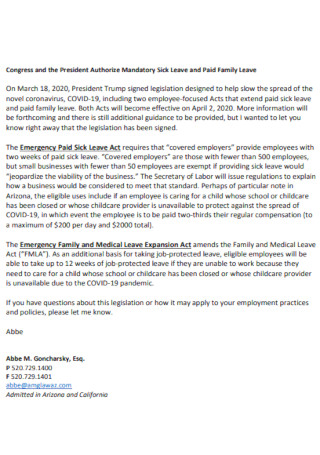
Mandatory Sick Leave and Paid Family Leave
download now -
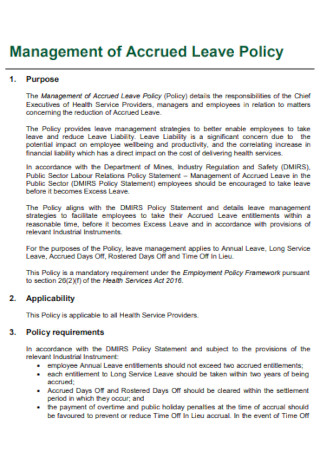
Mandatory Management of Accrued Leave
download now -
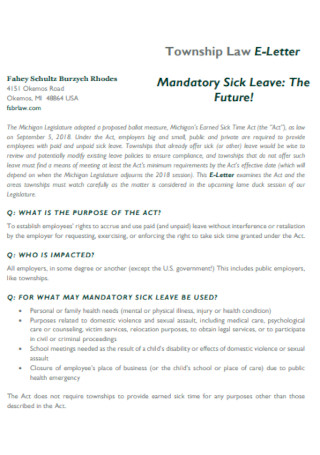
Basic Mandatory Sick Leave
download now -
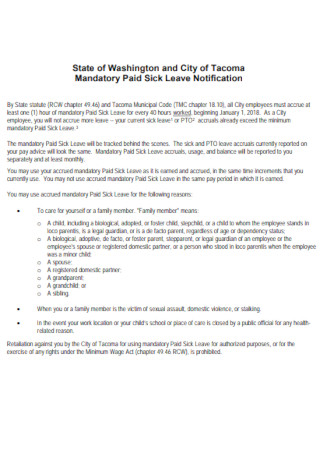
Standard Mandatory Paid Sick Leave
download now -

Sample Forced Leave
download now -
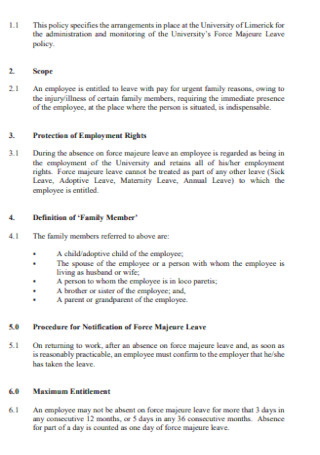
Sample Forced Majeure Leave
download now -

Sample Parental Force Leave
download now -
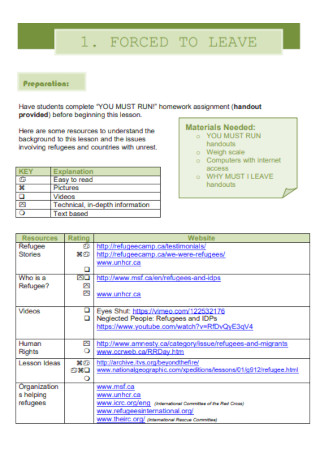
Basic Forced to Leave
download now -
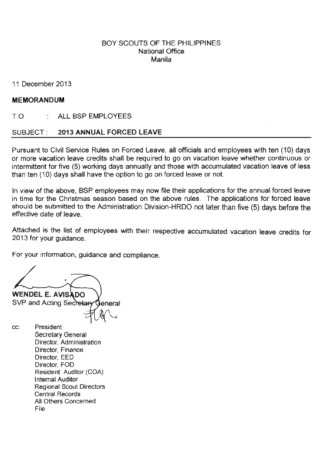
Sample Annual Forced Leave
download now -
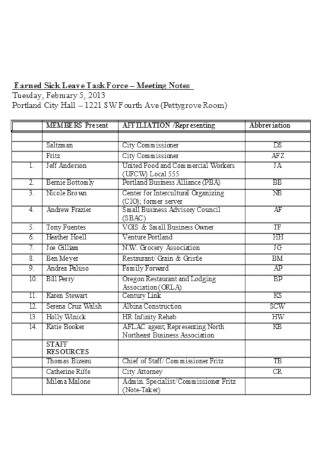
Forced Meeting Sick Leave
download now
FREE Forced and Mandatory Leave s to Download
Forced and Mandatory Leave Format
Forced and Mandatory Leave Samples
What is a Forced and Mandatory Leave?
Benefits of Enforcing Forced/Mandatory Leave
How To Enforce a Forced and Mandatory Leave
FAQs
Am I required to keep paying my employees even when they are on leave?
Do I need a leave of absence request form to use in my business?
What is the difference between a mandatory leave of absence and a voluntary leave of absence?
What should companies include in a mandatory leave policy?
What are the legal risks of imposing mandatory leave?
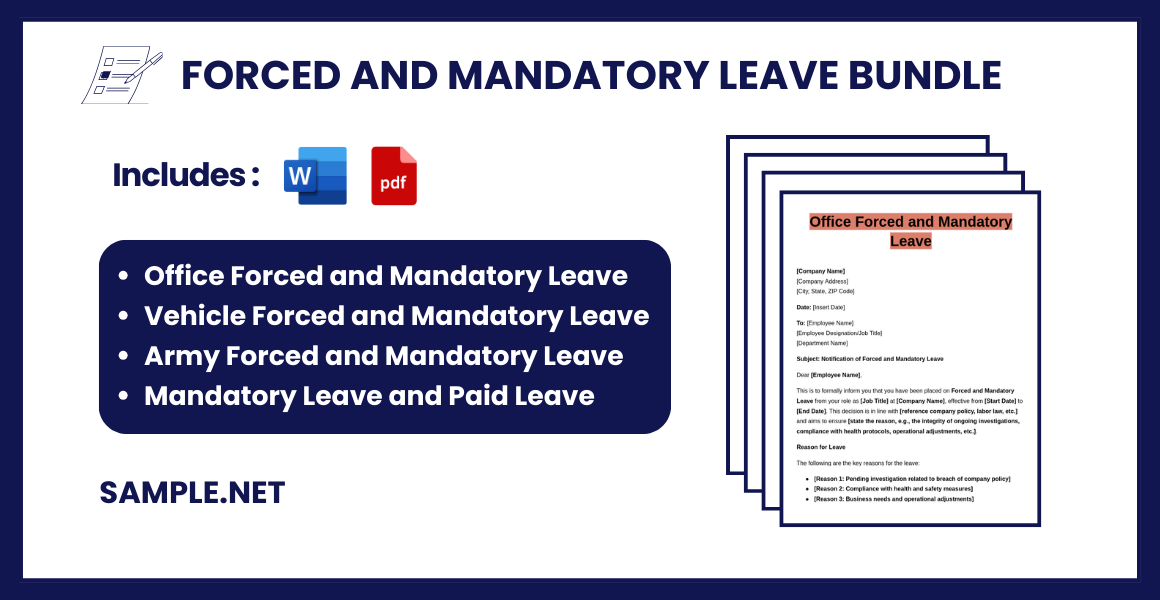 Download Forced and Mandatory Leave
Download Forced and Mandatory Leave
Forced and Mandatory Leave Format
[Company Name]
[Company Address]
[City, State, ZIP Code]
Date: [Insert Date]
To: [Employee Name]
[Employee Designation/Job Title]
[Department Name]
Subject: Notification of Forced and Mandatory Leave
Dear [Employee Name],
We hope this message finds you well. This letter is to formally notify you of your placement on a forced and mandatory leave of absence from your role as [Job Title] at [Company Name], effective from [Start Date] to [End Date]. This decision has been made following a thorough review of the current circumstances and in accordance with company policies and applicable labor laws.
Reason for Mandatory Leave
The reason for this mandatory leave is as follows:
- [Reason 1: Example: Ongoing investigation related to company policy]
- [Reason 2: Example: Health and safety compliance requirements]
- [Reason 3: Example: Organizational restructuring or downsizing]
The decision has been made to ensure [state the objective, e.g., “the integrity of the investigation” or “the health and safety of employees”].
Duration of Leave
- Start Date: [Insert Date]
- End Date: [Insert Date]
Please note that the duration of this leave may be subject to change depending on the progress of [investigation, health protocols, etc.]. Any adjustments to this timeline will be communicated to you promptly.
Compensation and Benefits
During this leave period, you will be entitled to the following:
- Salary/Compensation: [Specify if paid, unpaid, or partially paid]
- Health Insurance: [Specify coverage details]
- Other Benefits: [Specify any other applicable benefits]
Please note that this period of leave will [mention if it will be considered part of paid time off, unpaid leave, etc.].
Responsibilities During Leave
While on leave, you are expected to adhere to the following guidelines:
- Access to Work Systems: [State if access to email, work accounts, etc., is restricted]
- Communication: [Specify how the employee should remain in contact with HR or management]
- Availability: [Specify if the employee should remain available for any required communication]
Return to Work
You will be informed of your return-to-work schedule and any related procedures at least [mention notice period, e.g., one week] before the end of your leave period. Failure to comply with the instructions outlined in this letter may result in further action.
Contact Person
If you have any questions or require further clarification regarding this leave, please do not hesitate to contact [HR Representative/Manager Name] at [Phone Number] or [Email Address]. We are here to assist you during this period.
Acknowledgment and Acceptance
Please acknowledge receipt of this letter by signing and returning a copy of it to [HR Department/Manager] by [Deadline Date].
Sincerely,
[Your Name]
[Your Designation]
[Company Name]
[Email Address]
[Phone Number]
Acknowledgment of Receipt
I, [Employee Name], acknowledge the receipt of this Forced and Mandatory Leave Notification. I understand and agree to the terms outlined in this letter.
Employee Signature: _________________________
Date: _________________________
Witness (Optional): _________________________
Date: _________________________
What is a Forced and Mandatory Leave?
In the United States, an employer is legally allowed to force their employees to take a leave of absence. A leave of absence is when an employee takes time off from work; this could either be a paid or unpaid leave—depending on the employee’s eligibility for paid leave. Many companies in the US offer leave benefits to their respective employees for various reasons. A company’s leave of absence policies is formed by law or usually as a result of collective bargaining between the employer and employee (or employee representative). There are certain kinds of leaves of absence that are mandated by law. Under the Family and Medical Leave Act, American employees are given up to twelve weeks of unpaid and job-protected leave per annum. In fact, under the Fair Labor Standards Act, employees are entitled to leave credits that they may use for annual leave plans or vacation purposes. A leave of absence may either be requested by the employee or the employer. When the employee requests a leave, it is called a voluntary leave of absence. On the other hand, when the employer requests the employee’s leave, it is called a forced and mandatory leave.
Benefits of Enforcing Forced/Mandatory Leave
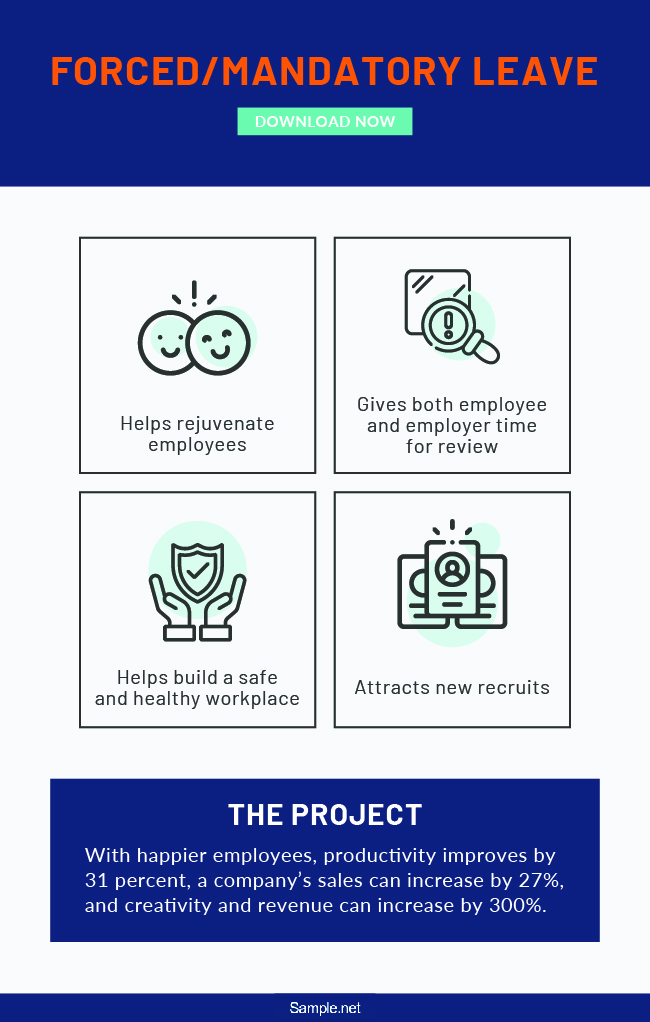
Under the law, employees are entitled to paid time off benefits such as vacation and sick leaves. Many companies take employees leaves seriously and even imposes mandatory vacations on their staff. Open-thinking business organizations offer forced and mandatory time off to their employees to help address inevitable work burnout in the workplace. It is not uncommon for an employer to require his employees to take at least two days to a week off work so he can work on his overall health. Studies even suggest that taking time off work is good for business. According to research conducted by The Project, companies that encourage vacation have happier employees. According to the research, with happier employees, productivity improves by 31 percent, a company’s sales can increase by 27%, and creativity and revenue can increase by 300%. To elaborate further, below are some reasons why enforcing forced and mandatory leaves can benefit a company.
1. It helps rejuvenate employees.
Working eight to ten hours a day, five days a week can take a toll on a worker’s physical and mental state. Employees often suffer from work burnout if exposed to too much pressure and stress due to heavy workload in the office place. As an employer, if you see an alarming behavior of your staff especially after a hectic work season, it may be best to force him to take a leave of absence. Time of work can help your over-worked employees a chance to recharge their physical and mental health. Whether they spend their day off sleeping, spending time with family or friends, or going out to socialize; by forcing them to take time off work they can place their stress aside and focus on their life outside of the workplace. They will come back to work feeling refreshed, energized, and ready to take on another round of work challenges. You can use our sample leave of absence forms to encourage employees to take time off work.
2. It gives both the employee and employer time for review.
Asking employees to take a mandatory leave of absence can give both the employer and employee time to evaluate. On the part of the employer, he can have time to assess the vacationing employee’s work ethic. An employer can enforce forced and mandatory leave for an employee under investigation. For example, an employee personnel in-charge of handling money is believed to be mishandling company funds. During investigations, he or she may be forced to take a leave of absence. The employer may then take the time to assess whether the accusations are true and he can then device what actions to take against the misbehaving employee. On the part of the employee, he can have time to evaluate his actions and reflect on them.
3. It helps build a safe and healthy workplace.
Getting time off work can lead to a more energized, creative, focused, and productive employee. Time offs can help employees work on their mental, emotional, and physical health. By encouraging employees to take leave of absences, your workplace can change into a safe and healthy environment full of lively and positive people. It is a well-known fact that tired and burned out employees make more mistakes compared to well-rested ones. That is why truck drivers, public transportation drivers, and plane pilots need sufficient numbers of hours worth of rest to avoid accidents causing the lives of others. Make us of time off request forms and help build a safe and healthy workplace by encouraging rest amongst your workers.
4. It attracts new recruits.
Companies are always scouting for new recruits. Often they compete with other companies for job-seeking industry talents. To a job applicant, a company offering more benefits to its employees is more attractive than the ones who do not. If you were in the shoes of a job seeker, you would most definitely choose a company offering paid time off more than the statutory minimum or those offering paid mandatory time off work. A company offering a promising work-life balance is highly attractive to a job applicant.
How To Enforce a Forced and Mandatory Leave
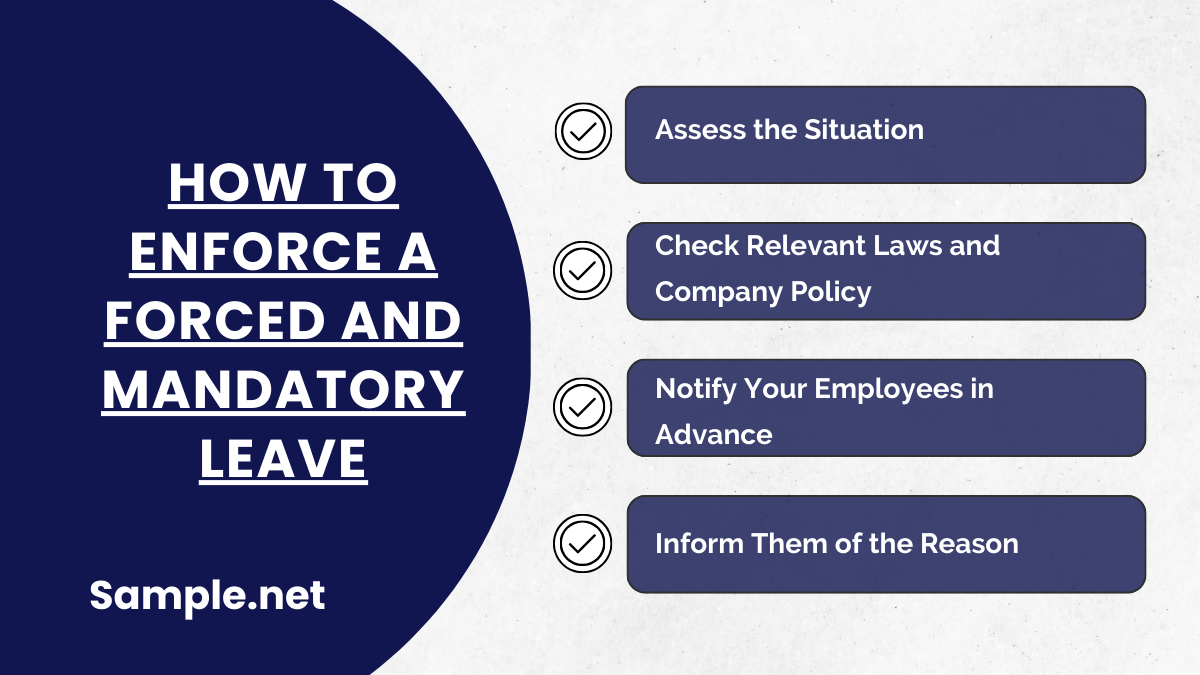
Forced and Mandatory Leave of Absence is a highly common way for business establishments to deal with economic hardships. The uncertainty of economic trends can decrease a business’s sales and can affect the overall business operation making it difficult to bounce back and continue paying employees payrolls. Hence, measures must be taken to prevent bankruptcy and full closure of the company. One way of saving the business is by forcing employees to take unpaid leave for the time being. It is perfectly legal and acceptable to force employees to take a leave of absence. Under the Fair Labor Standards Act, employers are given the right to restrict and even dictate how and when their employees can take their vacation leaves. To help guide you in enforcing forced and mandatory leave of absence orders, below are some steps you can follow.
Step 1: Assess the Situation
The first thing you should do is assess the situation, whether or not there is a need to place an employee under forced and mandatory leave of absence. In a business organization, there are what we call core employees. Core employees are the backbone of the business operations; without them, the business cannot operate at all. If you force a core employee to take a mandatory leave of absence, it can seriously affect the workplace operations flow. Hence, before laying off a staff member, make sure you know the repercussions of his absence.
Step 2: Check Relevant Laws and Company Policy
The most prevalent laws that govern and regulate paid vacation, sick leave, and holiday leave is your State Employment Laws. In its absence, an employee is protected by federal employment laws such as the Fair Labor Standards Act and the Family and Medical Leave Act. However, state and federal employment laws can be overruled by company policies provided they are a product of collective bargaining agreement between the employer and employees or employee’s representative. Before you can impose forced an employee to take a mandatory leave of absence, make sure the order is in compliance with state/federal laws and existing company policy regarding forced leaves. You can also see more on Study Leave.
Step 3: Notify Your Employees in Advance
It is always nice to observe courtesy when forcing your employees to take mandatory time offs. Hence, make sure you inform your employees a few days in advance that they are ordered to take a forced and mandatory leave of absence. An acceptable time span for notifying your workers that they’ll be taking time off work is a week in advance. However, for emergency situations, one or two days before the scheduled time off is enough time to notify them.
Step 4: Inform Them of the Reason
There is always a reason behind forced and mandatory leave of absences ordered by an employer. It would be impolite to not let them know why they are being forced to take a mandatory leave of absence. Some common reasons are as follows: the employee is under investigation, the company is undergoing business reverses, there is overstaffing, etc. Whatever reasons you have, make sure you explain them to the employee.
FAQs
Am I required to keep paying my employees even when they are on leave?
If the employee still has available or unused paid leave credits and has signified his intention to use those leave credits, then you are still required to keep paying them even when they are on leave. However, when they no longer have available leave credits and no company policy allows the leave to be paid, then you do not need to keep paying the employee. You can also see more on Leave of Absence Letters and Forms.
Do I need a leave of absence request form to use in my business?
In today’s generation, when an employee wants to request a leave of absence he can just call, text, or email his employer or the company HR informing them of his intention to take time off work. However, if you feel there is a need to use a printed form, you can use readily available sample template forms online. You can check out our website for a variety of sample leave of absence request forms that you can easily download, edit, and print.
What is the difference between a mandatory leave of absence and a voluntary leave of absence?
A mandatory leave of absence is often ordered by the employer to give his employee time off work while a voluntary leave of absence is one requested by an employee. Mandatory leave of absence is governed by federal and state laws while there are no laws that regulate or require voluntary leave of absence; they are merely a product of collective bargaining agreement between an employer and a labor union. You can also see more on Sick Leave Documents.
What should companies include in a mandatory leave policy?
A mandatory leave policy should cover the purpose, eligibility, duration, employee rights, payment terms (paid or unpaid), and the appeals process. Clearly defining these terms reduces legal risks and employee disputes.
What are the legal risks of imposing mandatory leave?
Legal risks include claims of unfair treatment, wrongful dismissal, or non-compliance with labor laws. Companies must follow legal guidelines for notice periods, payment entitlements, and justifiable reasons for leave. You can also see more on Self-Declaration.
